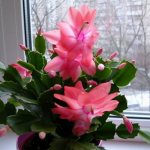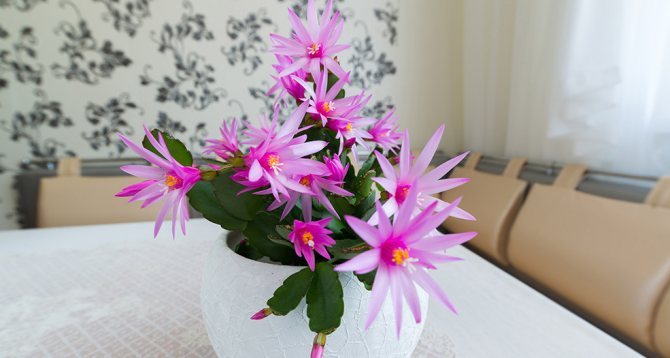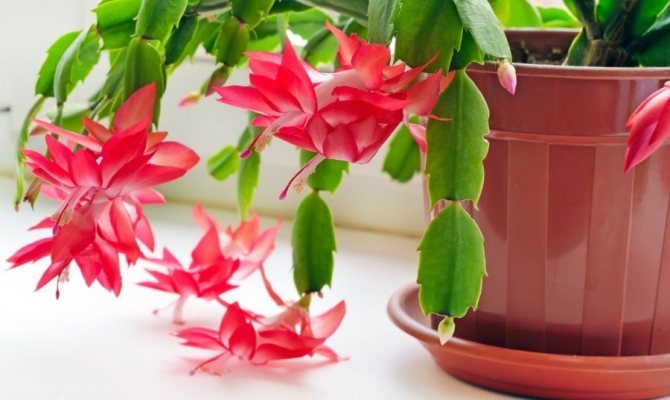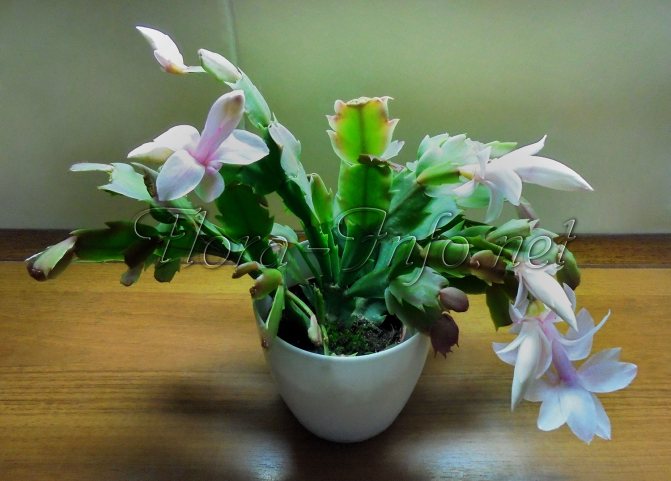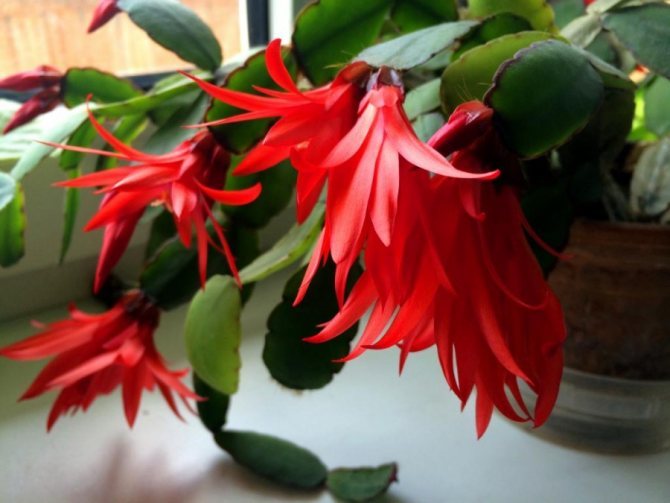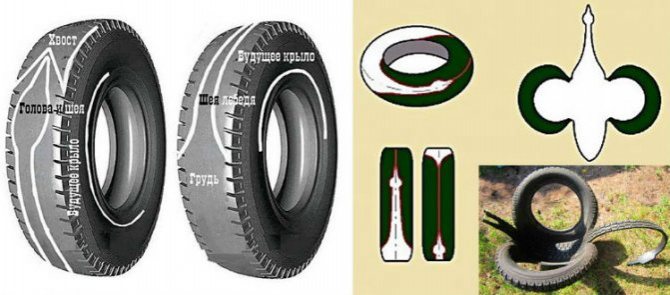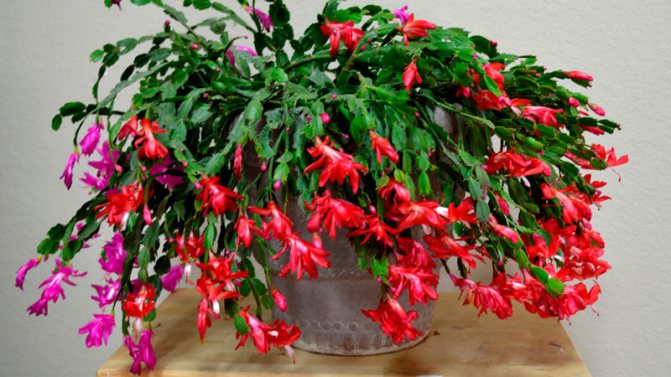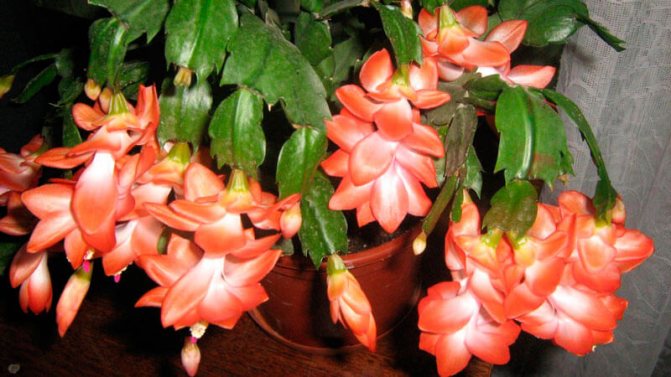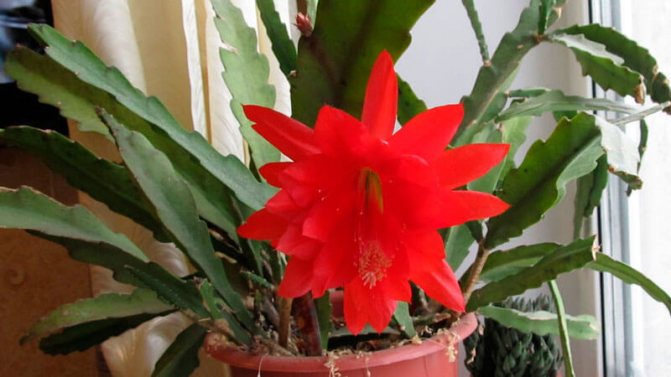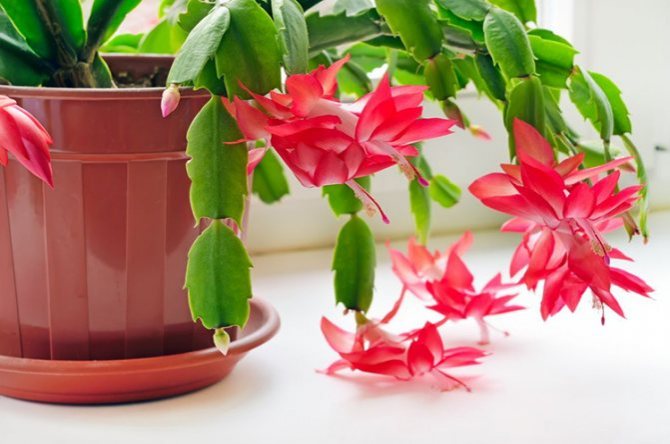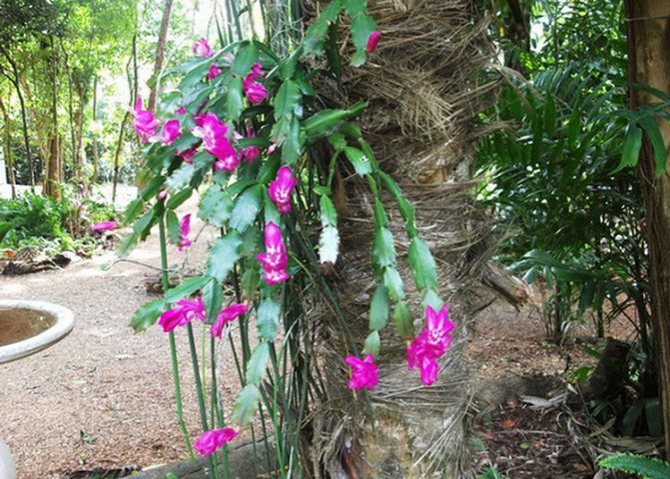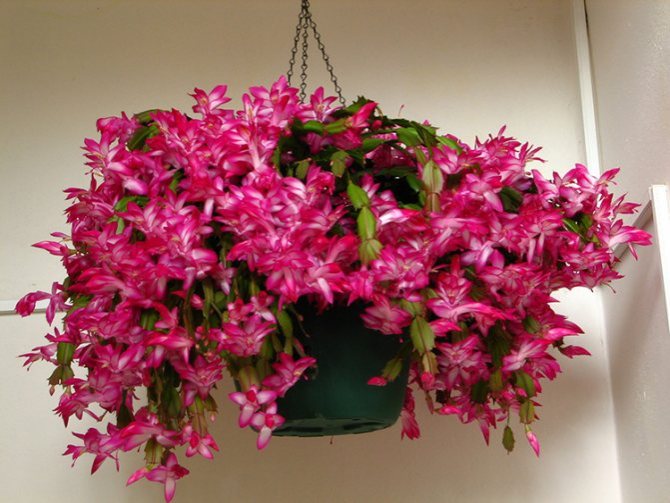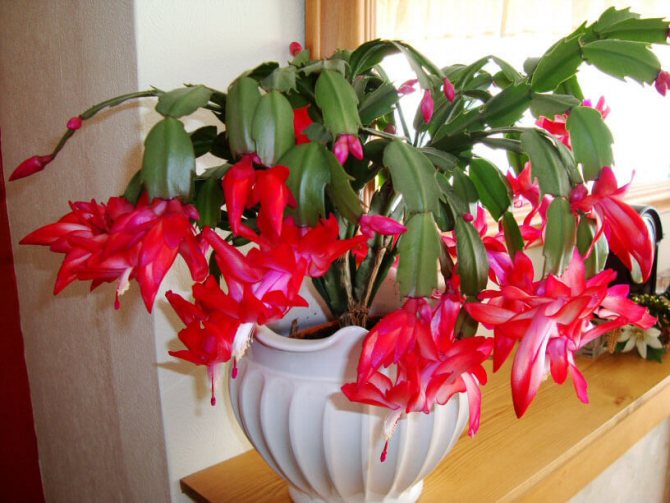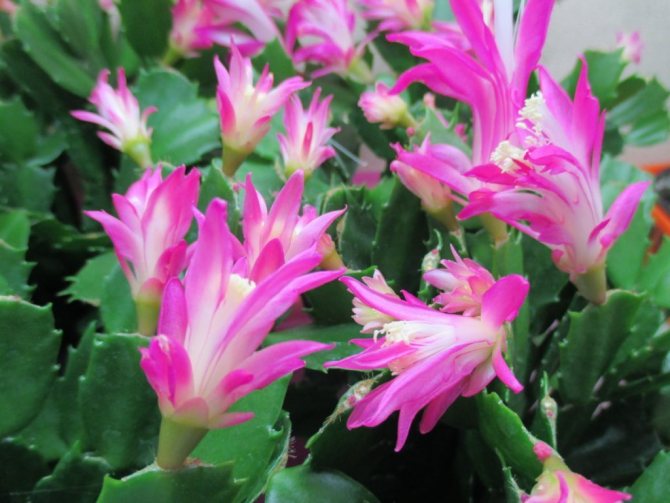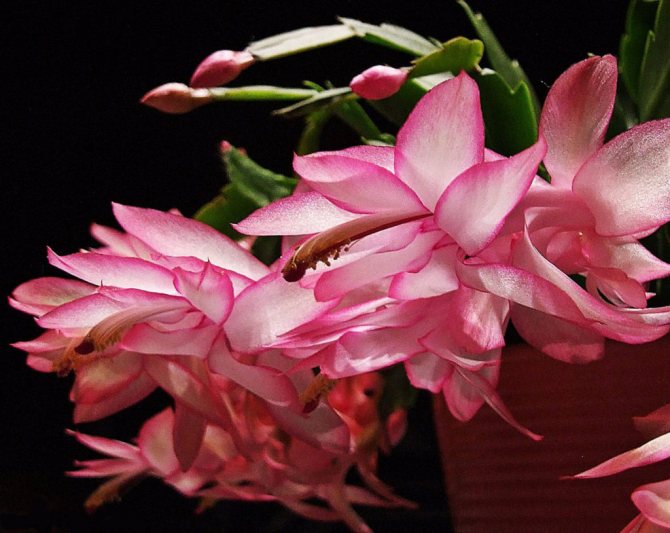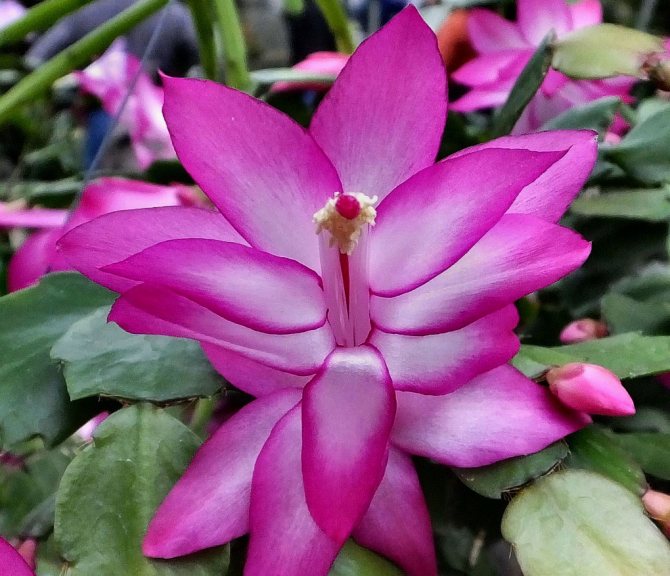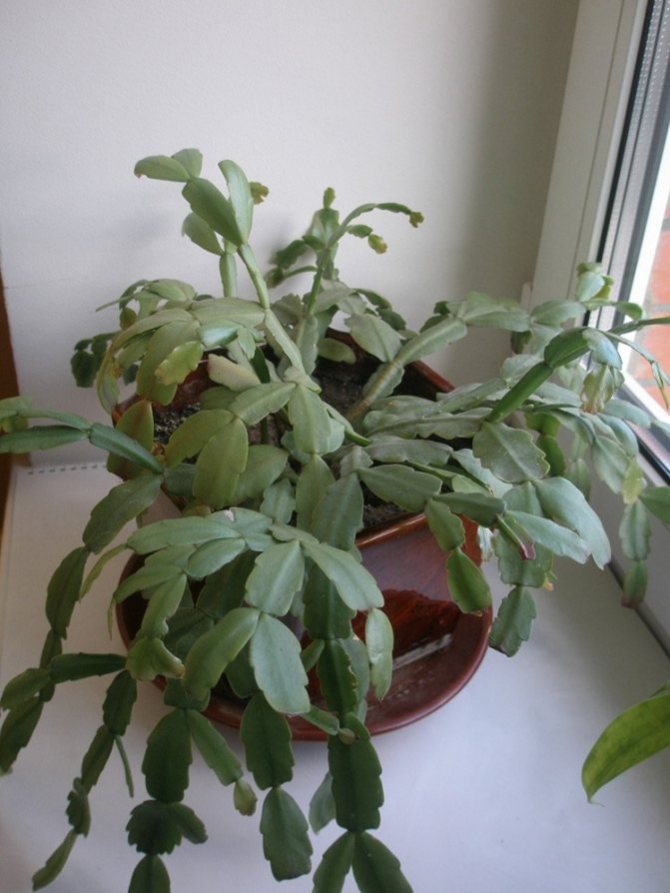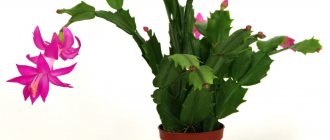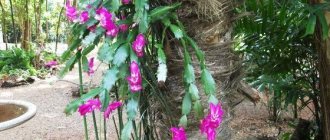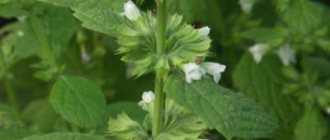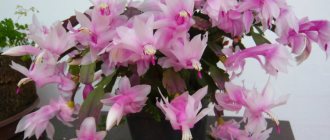The Decembrist is a forest cactus that does not have thorns. Under natural conditions, this epiphyte grows in tropical rainforests on tree trunks. The first specimens of zygocactus were brought from South America at the end of the 19th century.
It got its name in honor of the French explorer and botanist Frederic Schlumberger, who was the first to compile a detailed description of the epiphytic cactus growing on the trunks and branches of tropical trees.
Decembrist, or Christmas, the flower was named in Russia for flowering in winter. At the end of the last century, the plant was even presented as a gift for Christmas.
Description of the plant
The Decembrist is a half-shrub up to half a meter high, long branchy shoots of which hang down. The trunk is composed of numerous segments with jagged edges.
The root system of the cactus is very poorly developed. However, the Decembrist has a whole system of aerial roots and search roots, thanks to which it can receive moisture from the air.
Zygocactus blooms with bright large flowers, which, in combination with the shape of the leaves, create an unusual appearance. The flower is a multi-tiered inflorescence in natural conditions of white or red color, having a tubular structure and long stamens arranged in a bundle. In the wild, the plant is pollinated by giant moth moths or hummingbirds.
What conditions are needed for the natural formation of buds?
Lighting and a comfortable place
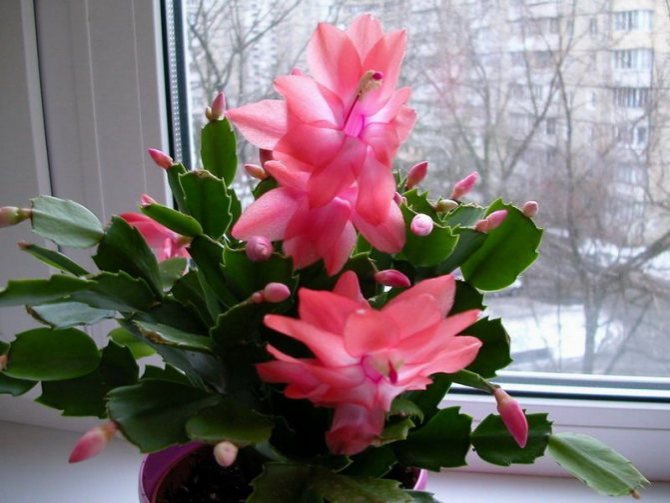
The Decembrist loves bright, but diffused lighting. It is necessary to exclude the possibility of direct sunlight falling on the plant - because of them, the Schlumberger slowly grows and develops, and its stems turn yellow. At the same time, the Decembrist also grows poorly in deep shade - daylight hours should last about 8-10 hours a day.
therefore it is best to place the zygocactus on the windowsill of the east or west window and shade, so Schlumberger feels most comfortable, being in conditions as close as possible to a tropical climate.
Temperature
The Decembrist is able to survive in different temperature conditions: he tolerates temperatures well both at +40 degrees and at +12 degrees.
Comparison! The most suitable temperature indicators are + 18-25 degrees.
Before the beginning of the flowering period, the air temperature must be lowered to + 15-16 degrees, when the buds are blooming, increase to + 18-25 degrees, and at the end of flowering, lower it again.
Air humidity
Schlumberger responds well to spraying... In summer, especially at high air temperatures, it is necessary to regularly and abundantly spray the plant with a spray bottle.
Array
Pot size for the Decembrist
The second rule for the Decembrist to bloom - small amount of earthy coma... A large pot for a Decembrist, like all cacti, is simply not needed. It will grow in it, but it is unlikely to bloom.
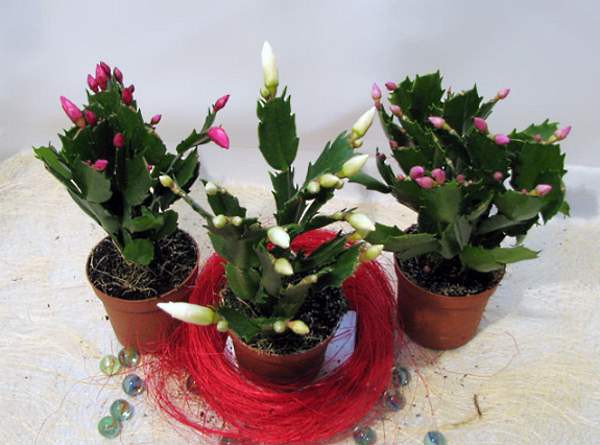

My Decembrist grows in pots 8-12 cm in diameter and 5-8 cm in height. The root system of the Decembrist is very compact.
Variety of species
Currently, breeders have bred a large number of Decembrist varieties with flowers, the petals of which are elongated and wide. They are painted in bright crimson, purple, yellow and pink, simple and terry in shape.The most popular among lovers of indoor flowers are the following varieties of zygocactus:
- Lavender Doll. The cultivar is a compact shrub with large segments. The plant has beautiful purple flowers. This type of Decembrist is grown as an ampelous plant. Annual pruning is required to form the shrub.
- Decembrist Gertner. This is a very large plant with dense thickened segments that reach a length of 5-7 cm. The petals of the flower are slightly elongated, the stamens are collected in a bunch that hangs down. The variety is distinguished by a variety of flower colors.
- Bookleys. A medium-sized shrub, the height of which reaches half a meter. The segments are colored dark green and have a glossy, shiny surface. Flowers consisting of several tiers attract particular attention. The length of the inflorescence is 8 cm. The color of the flower is quite varied. The flowering period is long and lasts from November to March.
- Russeliana. Zygocactus has long hanging shoots, which are 80 cm long. Due to their large size, the segments are similar to leaves. On the surface of the segment, there are veins protruding above the surface, the edges have small notches.
Reproduction
It is quite easy to propagate the Decembrist. To do this, in the warm season, the apex segments are cut. It is desirable that there are 2-3 segments each. They are not cut off, but unscrewed by turning them clockwise.
By this method, they are least of all injured, since they are easily separated from the mother bush. Now they are dried for two days and planted in a nutritious and loose substrate.
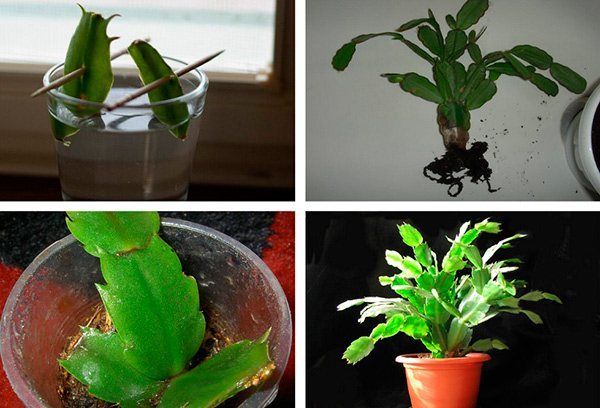

When landing, the lower segment is buried in the ground for 1/3 of its length. For planting a cutting, plastic cups with a volume of 100 grams are best suited. The soil is poured onto a third of the glass and the prepared cutting is planted.
Important! It is necessary that the soil meets the requirement and is nutritious.
How to care for a flower
Caring for a Decembrist is easy if you follow the recommendations of experienced gardeners. It is very important to correctly determine the location of the plant. The eastern side with diffused lighting is suitable for growing. When a flower is placed on the southern windows under the influence of direct sunlight, the segments of the plant begin to turn yellow and crumble. If placement on the east side is not possible, then the flower can be shaded.
During the formation of buds, it is strictly forbidden to rearrange or turn the pot with a zygocactus. This can lead to shedding of the buds. The Decembrist will not bloom during this period.
In summer, flowers can be kept outdoors - in the garden or on the balcony. Care must be taken to protect the Decembrist from cold winds and drafts.
When growing zygocactus in the summer in the open field, the plant is planted in a well-lit and sun-warmed place.
Temperature requirements
The flowering period of the plant occurs in late November - early March. After the Decembrist stops blooming, the pot with it should be moved to a cool room.
For normal growth and development of zygocactus, maintaining the temperature up to 25 degrees is required. During the budding period, it is lowered to 18 degrees.
Watering and humidity
Watering the zygocactus should be taken very carefully. It can be conditionally divided into three time periods:
- Flowering period. At this time, the Decembrist needs a lot of moisture. The soil must always be moist. However, waterlogging should not be allowed, as this can lead to decay of the roots and death of the plant.
- The period before and after flowering. Watering is carried out as the topsoil dries up. The plant needs the same amount of moisture as it does during flowering, but at a longer time interval.
- The dormant period, which falls in the summer. Zygocactus is watered as the top layer of the soil dries up. On hot days, you should systematically spray the plant or give it a warm shower. In this case, the soil surface should be covered with a plastic bag to prevent waterlogging.
Recommendations for abundant flowering
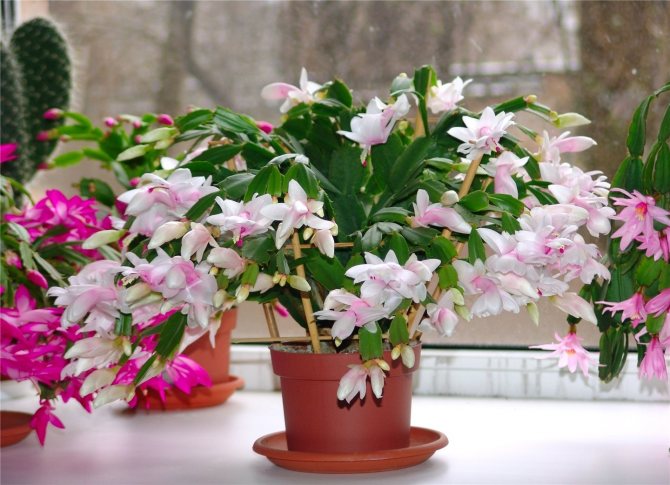

In order to make the Decembrist bloom, every winter you need to adhere to some tips.
- Refusal to move. The Christmas man really does not like to change his location often. Each time you transfer it to a new place, you need to remember that this is a lot of stress for a flower. He spends a lot of energy adapting to new conditions, so he often refuses to bloom.
- Rejuvenation. If the Decembrist does not bloom for several years, then the reason for this is old age. Therefore, you need to pick one or more branches and plant them in the ground. They take root very quickly and after 2 years they will delight the owner with their flowers.
- Fresh air. If in the warm season there is an opportunity to take out the pot with the Decembrist to fresh air, then you should not refuse it. The flower can be in the yard all summer long, for this it must be hidden from direct sunlight.
In apartment conditions, it is very difficult to withstand the temperature regime during the rest period of the Decembrist. There are several secrets to ensure a comfortable rest for him:
- Often set aside the plant under an open window.
- Find the coolest corner on the windowsill and enclose it with transparent glass or foil.
- Cover the heating radiators under the window on which Schlumberger is standing with a thick blanket.
- Arrange containers with ice around the flower pot and change the ice as it melts.
Of particular importance for the flowering of the Decembrist is the regular application of fertilizers. It must be fed during the entire period of active growth and completely stopped during rest.
The Decembrist is an unpretentious plant, but without proper care it can stop producing buds. For him, as for any flower, the attention of the owner is very important, for which he will repay with annual and lush flowering.
Reproduction of the Decembrist at home
Reproduction of the Decembrist at home is carried out by cuttings. For this, segments with small roots should be taken from the mother plant. Segments are taken from the most lush part of the bush. After that, the adult plant rejuvenates and gives new shoots.
It is recommended to pinch off the segments by hand, without using a knife. The prepared shoots are dried in air for several days, then planted in a previously prepared nutrient soil, consisting of leaf and turf soil, humus, sand and peat. A drainage layer should be laid in the pot.
Soil for flattering cacti
In nature, Schlumbergers are epiphytes that grow in crevices in the bark of trees. Therefore, the soil for planting the Decembrist at home should be as loose, moisture and air permeable as possible.
A proven recipe for soil composition for zygocactus: leaf earth + coarse sand in a 1: 1 ratio. It is recommended to use a small amount of charcoal and peat as an additive to this mixture.
Schlumberger transplant is carried out every 1-2 years. This is done not immediately after flowering, but during the resumption of growth (the beginning of the growing season) - from mid-March to the end of April.
For transplantation, a pot is selected 2 cm larger in diameter than the previous one. The pot may be small in height, since the root system of zygocactus is superficial and does not go deep into the ground. Drainage holes and a drainage layer (expanded clay, polystyrene, pieces of broken brick), 2-3 cm thick are required.
The Schlumbergers talk about the transplant in the video:
Why does the plant not bloom or wither
The main reason is improper plant care. With the onset of autumn, when the formation of buds begins in the Decembrist, a dormant period should be provided for the flower. To do this, a pot with a cactus is placed in a cool room with an air temperature of up to 22 degrees and the amount of watering is reduced. In November, the plant is transferred to a bright place and watering is increased. At this time, the plant begins to form buds.
In winter, the flower needs additional lighting. During flowering, you should not turn and move the pot with the plant, and also take cuttings for propagation.
A plant growing in a narrow pot will bloom profusely.
If the flower is kept in a room with a low air temperature, then the flowering period will last longer.
A cactus can wither when affected by fungal diseases or as a result of rotting of the root system. If the flower has become unstable, then its roots have rotted. This happens when the plant is watered with cold water, an overabundance of mineral fertilizers in the soil, overheating or overcooling of the flower. In this case, the plant is transplanted into fresh soil, after removing the rotten roots and sprinkling the root system with chopped charcoal.
Transfer
The transplant is carried out after flowering - at the end of February or in the middle of March. A young Decembrist needs to be resettled every year, at the age of 5 years - after 2-3 years, after 10 years of age - once every 4–5 years. Prepare the pot: it should not be too large and slightly narrowed. Then remove the plant from the old flowerpot. To do this, loosen the soil around the edges of the container and carefully remove the Decembrist. Peel the soil off the root very carefully. Place the plant in a prepared new pot of soil.
To get the most suitable soil, mix in equal proportions turf and leafy soil, sand, peat. You can buy specially formulated cactus soil from the store. Drainage is required. It should occupy one third of the total capacity. You can use crushed brick or medium sized expanded clay.
The Decembrist flower is best transplanted at the end of February - mid-March.
Cover the root of the plant with soil. It does not need to be over-rammed. Moisten the soil. For the first few days, make sure that the soil does not dry out. A healthy appearance of jointed shoots is a sign of normal adaptation to new conditions. If the flower does not take root, it becomes lethargic, loses its shape.
How to make the Decembrist bloom
In order for the plant to bloom, you should use the following rules:
- transplant the flower into a narrower and cramped pot;
- provide a cooler temperature regime;
- during flowering, do not move or turn the cactus pot;
- create additional lighting using phytolamps or fluorescent lamps;
- during the period of bud formation, move the plant to a room with an air temperature not higher than 16 degrees.
Top dressing using mineral fertilizers should be stopped at the end of summer. It is also necessary to gradually reduce the watering of the plant. If you do this very sharply, then the flower can throw off the already formed buds.
Why hasn't the Christmas tree been blooming for several years?
The lack of a flowering period in the Decembrist indicates the lack of the necessary care and not observing the conditions for keeping the plant:
- Schlumberger is in a too dark place, for example, on a windowsill on the north side of the room. The most suitable option is an east or west window sill.
- The plant lacks nutrients. The Decembrist needs constant feeding, otherwise it grows, but does not bloom.
- Wrong watering regime. As a result of a lack of moisture or its excess, the destruction of the root system of the plant begins and the development of diseases, which negatively affects flowering.
- Pests. The presence of insects also negatively affects the condition of the Decembrist roots.
- Pot too big. Schlumberger roots do not take up much space, so planting in too large a container will lead to the fact that the plant will use its strength to build up and develop the root system, forgetting about flowering.
- Lack of regular replanting and, as a result, complete depletion of the soil and weakening of the roots.
Moreover, stress, leading to a lack of flowering, can also be provoked by frequent plant movements from place to place, even to the rotation of the flowerpot around its axis, the Decembrist reacts painfully. We talked in more detail about the reasons for the lack of flowers in a Christmas tree in this article.
Possible growing problems
Despite the rather simple care of the Decembrist, an inexperienced florist may encounter some problems when growing it, for example, with the lack of bud formation, falling off of inflorescences, or damage to the plant by diseases and parasites. This usually happens if the owner of the flower does not properly care for it.
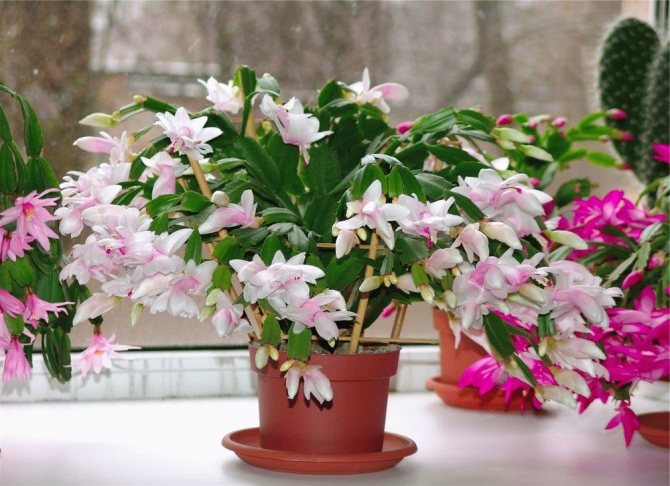

Why does it bloom poorly
Here are some common mistakes in caring for a Christmas tree that contribute to poor flowering or no flowers at all:
- lack or overabundance of lighting;
- sudden changes in temperature in the room;
- moving a flowerpot with a flower from its usual place;
- an excessively large and tall container in which the flower develops an excessive volume of the root system, and it directs all its forces to its development;
- the soil in the pot does not meet the requirements for flowering zygocactus;
- there is no timely additional feeding of the crop;
- the plant did not have a dormant period;
- flooding the soil with water, or vice versa, excessive drying out of the earthen feed in the pot;
- incorrect phyto-orientation of flowers with frequent rotation of the pot with a plant (usually the flowers are oriented towards the sun, therefore, with frequent rotation of the flowerpot, the laying of inflorescences may stop);
- location of the bush on the sunny side without shading.
Find out in more detail why the Decembrist does not bloom at home and what to do at the same time, and also read how to transplant, water and feed the Decembrist correctly.
Why do flowers fall
Another problem with growing a Christmas tree is the fall of its already appeared buds. The causes of the problem can be different.
Among them:
- rearranging the pot during flowering to another place or under the direct rays of the sun;
- abundant watering;
- lack of moisture both in the soil and in the air;
- drafts;
- non-nutritious soil in a flowerpot;
- damage to the plant by diseases of fusarium, phytafluoro, phytium, in which not only the buds, but also the leaves wither and fall off (usually the treatment of these diseases is not effective, therefore the plants are destroyed along with the flowerpot);
- if the flower has not been transplanted for a long time.


Also, the Decembrist may be attacked by harmful insects, such as spider mites, scale insects, mealybugs, or get sick with powdery mildew (insects are destroyed with insecticides "Aktellik", "Fitoverm"; if affected by powdery mildew, it is necessary to change the soil in the flowerpot and reduce the watering of the plant ).
You can read more about the diseases of the Decembrist.
As you can see, growing a Decembrist in an apartment is not associated with overly time-consuming rules and requirements. If a florist is able to organize at home conditions for culture that are close to natural, then the abundant flowering and healthy appearance of the Christmas tree will delight its owner throughout not only the coming winter, but also for long years.
Features of the flowering period of the Decembrist
During the blooming of the buds, the Christmas bush is covered with bilaterally symmetrical flowers of various colors (most often lilac, red, white, pink, purple, orange).The flowers are located at the ends of the jagged shoots of the plant.
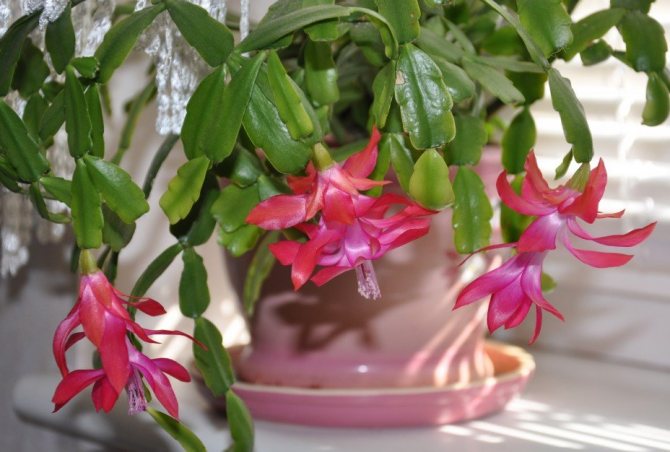

In the conditions of an apartment, the buds of the plant are not very large, although at home, in the tropics of Brazil, flowers can be up to 8 cm in size.Without proper care, it is impossible to achieve blooming of inflorescences in the culture. This will help the preparation of the zygocactus for this period and the creation of optimal conditions for it.
Did you know? The Christmas tree is a long-lived plant, because with proper care, the culture, being in one place in an apartment, can safely grow and develop up to 20 years, and in a greenhouse or botanical garden - up to 150.
Signs and superstitions
All the signs associated with the early flowering of Schlumberger promise good luck and an improvement in the financial situation in the family for the whole next year.
Blooming on time cactus in a creative person promises the owner new horizons in work.
The lush bloom of the cactus is associated with a lot of positive emotions in the house. But this does not mean that the Decembrist flower is a donor or a vampire. It's just that the happier the people in the house are, the more care they take with the plant. And it responds to love with abundant flowering.
The variety of Decembrist varieties allows you to choose specimens that meet the tastes of each cactus grower. And unpretentiousness and the ability to adapt makes possible cultivation of this plant in the collections of beginners. The main thing is to follow the care regimes and treat your pets with love.
Pests on the way to bloom
Sometimes the Decembrist does not bloom, since all his strength is spent on fighting pests and infections. Carefully examine the leaves of the plant, perhaps they are affected by a spider mite or late blight. Both infections negatively affect both stems and buds. Ultimately, the Decembrist may either not bloom at all, or all of its buds will simply disappear without opening. In this case, the plant should be sprayed with medications that will kill the infection. In especially advanced cases, a plant transplant may be necessary.
So that pests do not start in a flowerpot with a Decembrist, try to create conditions unsuitable for them. Ventilate the area where the flower is often. Water and loosen the soil in the pot in moderation. An abundance of air and a minimum of moisture are conditions in which pests do not start.
Diseases and pests
Dangerous diseases for the Decembrist are considered ethereum, fusarium, late blight. Infection occurs through the soil or wounds. Disease is determined by falling leaves, lethargy. Fungicides and other drugs are used as a solution to the problem.
If a spider mite has reached the flower, which can be recognized by identifying yellow, red, rusty dots on the plant, then they fight the pest with anti-mite agents.
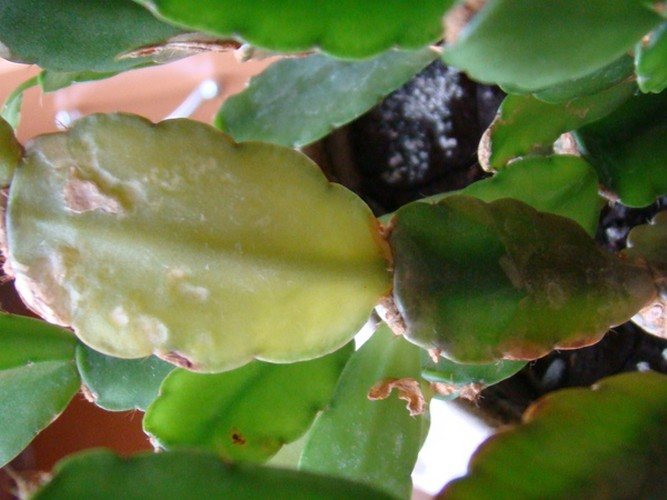

If the culture is attacked by a mealybug - the appearance of white lumps on the flower, then you should resort to chemicals, and also control the watering of the plant.
Soil for the Decembrist indoor
Particular attention should be paid when choosing a soil, the Decembrist loves light soil with good drainage. The soil must allow moisture and air to pass through. In most cases, a mixture of peat, earth and sand is used, you can add humus and sod. Better that the soil is slightly acidic, you can use a mixture for succulents.
Before planting a plant, the soil must be disinfected. For this, crushed coal is used. To make the soil more airy, add small pieces of bark and perlite.

